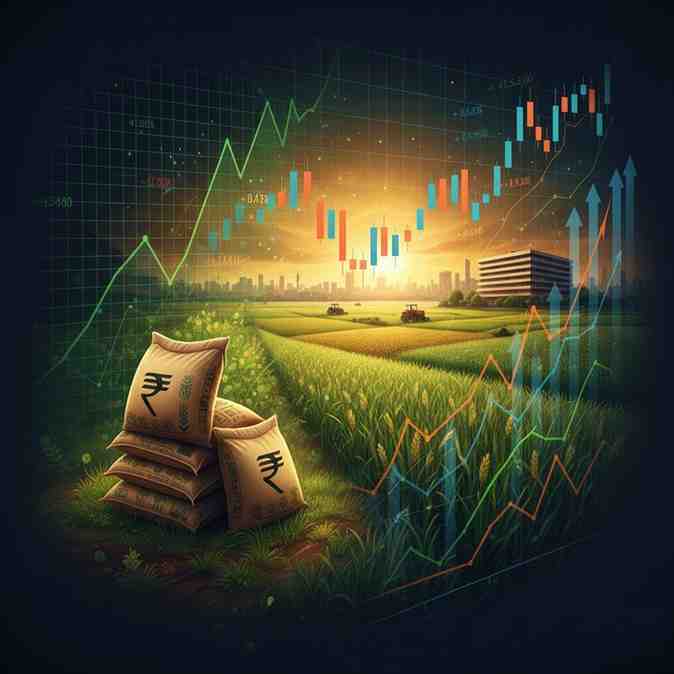
How Commodity Price Fluctuations Affect Fertilizer and Agri Stock Performance
How Commodity Price Fluctuations Affect Fertilizer and Agri Stock Performance
Commodity prices are the heartbeat of the agricultural and fertilizer industries. From urea and potash to crude oil and natural gas, movements in global commodity markets can significantly influence the profitability of fertilizer producers and, in turn, the performance of agri-related stocks.
Thank you for reading this post, don't forget to subscribe!For investors in India, understanding the commodity price impact on fertilizer stocks is essential. The agri sector’s sensitivity to input costs, government policies, and global trade trends makes it a complex yet rewarding segment to follow. This blog explores how shifts in commodity prices shape the fertilizer industry outlook in India, and what they mean for agriculture stock performance.
1. Understanding the Link Between Commodities and Fertilizer Stocks
Fertilizer companies rely heavily on commodities such as natural gas, ammonia, phosphates, and potash as raw materials. Any fluctuation in these input costs directly impacts their margins. For example, natural gas serves as both a feedstock and an energy source for urea production, making it one of the most critical cost components.
When global gas or crude oil prices rise, fertilizer manufacturers face higher production expenses. Unless the government increases subsidies or companies pass on costs to end users, profit margins tend to narrow. This explains why investors often track global commodity trends and agri stock returns together—they are closely intertwined.
In contrast, when commodity prices stabilize or decline, production becomes more cost-efficient, improving the outlook for fertilizer firms and potentially driving positive agriculture stock performance in India.
2. Impact of Crude Oil and Raw Material Prices
The impact of crude oil prices on fertilizer costs is particularly notable. Crude oil indirectly affects logistics, transportation, and the prices of petrochemical-based inputs used in fertilizer production. Rising oil prices inflate freight costs, making both domestic and imported fertilizers more expensive.
Similarly, fluctuations in phosphate rock, ammonia, and potash prices affect non-urea fertilizer producers. When these raw materials become costly, companies either adjust retail prices—subject to regulatory limits—or absorb part of the increase, which pressures profit margins.
This ongoing cycle highlights why rising raw material costs for agri businesses often translate into short-term stock volatility.
3. Global Demand and Supply Dynamics
Commodity prices are shaped not only by cost structures but also by global demand and supply conditions. Strong agricultural demand in countries like China, Brazil, and the United States can push fertilizer prices higher, impacting input costs for Indian firms. Conversely, oversupply or trade restrictions can create price softness.
The global demand for fertilizers often follows cyclical patterns based on harvest seasons, government procurement policies, and food inflation. Indian investors should watch these indicators closely, as they offer clues to how commodity market influence on agri investments might evolve over time.
For instance, during years of good monsoon rainfall, domestic demand for fertilizers typically rises, benefiting producers. However, if international commodity prices simultaneously spike, profit margins may still remain under pressure despite higher sales volumes.
4. The Indian Fertilizer Sector: Structure and Policy Dependence
India’s fertilizer sector operates under a mix of market pricing and government control. Urea, a key nitrogen-based fertilizer, remains highly regulated, while non-urea varieties enjoy more pricing flexibility. The government plays an active role through subsidy policies for fertilizers, ensuring affordability for farmers while balancing fiscal expenditure.
These government subsidy policies for fertilizers are critical to stock valuations. Any delay in subsidy disbursement affects working capital cycles for fertilizer companies, impacting liquidity and short-term profitability.
Additionally, agri input companies in India must align their production strategies with policy revisions, import quotas, and nutrient-based subsidy (NBS) scheme changes. This dependence on regulatory support creates both opportunities and risks for investors.
5. Fertilizer Sector Trends and Challenges
Several fertilizer sector trends and challenges continue to shape the industry’s trajectory:
- Volatile Input Costs: Frequent swings in global commodity prices create uncertainty in cost management.
- Subsidy Rationalization: Government efforts to reduce fiscal pressure may alter the subsidy structure, affecting cash flow.
- Energy Efficiency: Companies are investing in modern, energy-efficient plants to reduce dependency on imported feedstock.
- Import Dependence: India relies heavily on imports for raw materials like potash and phosphates, exposing it to international price risk.
- Environmental Regulations: Stricter emission norms are pushing companies to adopt sustainable production practices, adding compliance costs.
These factors collectively shape Indian agri and fertilizer stock market trends, influencing valuation multiples and investor sentiment.
6. Inflation and Its Broader Impact on Agriculture Stocks
Inflation plays a dual role in determining agriculture stock performance in India. On one hand, higher food prices can improve farm incomes and boost demand for fertilizers and seeds. On the other hand, inflation-driven cost pressures—especially for imported commodities—can increase input prices and compress profit margins for agri companies.
Inflation and agricultural commodity prices are closely linked. Persistent inflation in food or fuel segments can prompt government intervention in the form of export curbs or price controls, which may temporarily distort supply-demand dynamics. Investors tracking the sector should therefore monitor inflation data alongside commodity movements to make informed decisions.
7. Supply Chain Issues and Geopolitical Factors
Global events such as trade disputes, geopolitical conflicts, or shipping disruptions often create supply chain issues in the agri sector. For example, the Russia–Ukraine conflict disrupted fertilizer exports and drove up global potash and ammonia prices, directly impacting Indian importers.
These disruptions not only affect availability but also introduce price volatility in global commodity markets. Companies with diversified sourcing and long-term contracts are typically better positioned to manage such risks, highlighting the importance of operational resilience in risk management for agri investments.
8. Opportunities Amid Volatility
Despite its cyclical nature, the Indian fertilizer and agri sector offers steady, policy-backed growth opportunities. Government initiatives focused on soil health, balanced nutrient use, and domestic manufacturing under the “Atmanirbhar Bharat” framework are encouraging self-reliance and modernization.
Investors who understand the commodity market influence on agri investments can identify periods when valuations are attractive due to temporary input cost spikes or policy adjustments. Long-term demand fundamentals—driven by population growth, rising food consumption, and sustainable farming practices—remain intact.
Conclusion
Commodity price fluctuations are an inherent part of the agri and fertilizer ecosystem. Their effects ripple through production costs, margins, and ultimately, stock valuations. For investors, tracking global commodity trends and agri stock returns alongside policy updates and inflation data offers a clearer picture of sectoral health.
While the industry faces cyclical headwinds such as farm input price volatility and subsidy uncertainties, its structural drivers remain strong. As India continues to balance growth, self-sufficiency, and sustainability, the fertilizer sector will likely evolve in step with global market trends—offering both challenges and opportunities for informed investors.
Related Blogs:
Fertilizer and Agriculture Stocks: How Supply Chain Disruptions Ripple Through the Market
Long-Term vs Short-Term Risks in Indian Fertilizer and Agriculture Stocks
Decoding Fertilizer Subsidies: How Government Policy Impacts Your Stocks
Global Gas Prices & Their Ripple Effect on Indian Fertilizer Stocks
The Future of Farming: Are Nano Fertilizers the Next Big Thing for Indian Agriculture Stocks?
Riding the Monsoon: How Seasonal Rains Influence Fertilizer Stock Performance
Best Fertilizer Stocks in India
5 Best Chemical Stocks for Long-Term Investment in India
Top 5 Chemical Stocks in India
Best Chemical Stocks in India
Top 5 Oil and Gas Stocks in India
Renewable Energy Stocks: A Core Component of a Robust 2025 Portfolio
Best Green Energy Stocks in India 2025
Top 5 Fertilizer Stocks in India
Best Fertilizer Stocks in India
Best Pharmaceutical Stocks in India
Disclaimer: This blog post is intended for informational purposes only and should not be considered financial advice. The financial data presented is subject to change over time, and the securities mentioned are examples only and do not constitute investment recommendations. Always conduct thorough research and consult with a qualified financial advisor before making any investment decisions.

